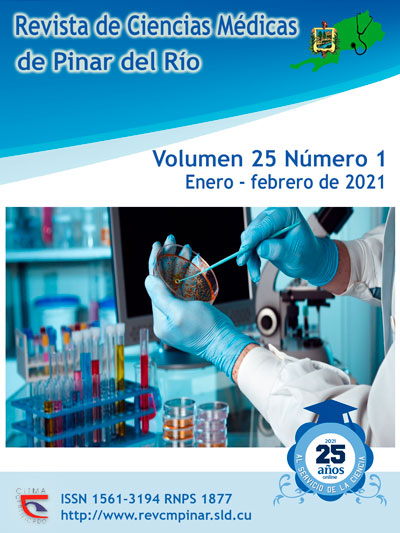Preserving vision as a professional acting-mode in Ophthalmology
Keywords:
OPHTHALMOLOGY, EYE HEALTH.Abstract
Introduction: professional acting-mode is a complex and dynamic didactic category that requires its improvement according to the social mission and working context of each professional.
Objective: to base the proposal of preserving vision as a way of professional acting-mode in the specialty of Ophthalmology.
Methods: the dialectic method was used as a guide. From the theoretical level, the historical-logical, modeling and systemic-structural methods were applied, including as procedures the analysis-synthesis and the induction-deduction; along with the documentary revision from the empirical level.
Results: preserving vision was interpreted as a generalized activity of the profession that contains a sequence of more general actions (promoting visual health, preventing visual alterations, diagnosing alterations in the visual health process, treating alterations in the visual health process and rehabilitation (visually); which is closely related to other categories such as: object of the profession (visual health as a process), object of work (visual system/vision), knowledge, professional skills and professional acting-mode.
Conclusions: it is based on “preserving the vision” as a unique and practical way of professional acting-mode which favors a high level of professional performance and aims at professional and human development.
Downloads
References
1. Rodríguez Fuentes S, Breijo Worosz T. Estrategia para el desarrollo de modos de actuación profesional competentes en los profesores habilitados. Rev Mendive [Internet]. 2017 [citado 26/06/2019]; 15(4): 480-491. Disponible en: http://mendive.upr.edu.cu/index.php/MendiveUPR/article/view/1224/html
2. Miranda Lena T. El modo de actuación profesional y su formación en las carreras pedagógicas. Revista Científico-Metodológica Varona [Internet]. 2011[citado 26/06/2019]; (53): 24-28. Disponible en: https://www.redalyc.org/pdf/3606/360635575004.pdf
3-Álvarez de Zayas C. Didáctica. La escuela en la vida. La Habana: Pueblo y Educación; 1999.
4-Álvarez de Zayas RM. Hacia un currículo integral y contextualizado. La Habana:
Editorial Academia; 1997.p.44.
5-Horruitier P. La universidad cubana: el modelo de formación. La Habana: Editorial Félix Varela; 2006. p.117.
6-Fuentes H. Didáctica de la educación superior. Santiago de Cuba: Editorial Oriente; 2000.
7-Addine Fernández F. El modo de actuación profesional pedagógico: apuntes para una sistematización. [Folleto]. En la compilación Modo de actuación profesional pedagógico. De la teoría a la práctica. La Habana; 2006.p.1-4.
8-Salas Perea R, Salas mainegra A. Los modos de actuación profesional y su papel en la formación del médico. Rev EDUMECENTRO [Internet]. 2014 Ago [citado 26/06/2019]; 6(2): 6-30. Disponible en: http://scielo.sld.cu/scielo.php?script=sci_arttext&pid=S2077-28742014000200002&lng=es
9-Herrera Miranda GL. Concepción pedagógica del proceso de formación de habilidades investigativas. Rev Ciencias Médicas [Internet]. 2014 Ago [citado 26/06/2019]; 18(4): 639-652. Disponible en: http://www.revcmpinar.sld.cu/index.php/publicaciones/article/view/1528
10-Sixto Fuentes S. Concepción pedagógica del proceso de formación de habilidades profesionales en la especialidad de Oftalmología. Estrategia para su implementación en la Universidad de Ciencias Médicas de Pinar del Río. [Tesis Doctoral]. Pinar del Río: Universidad Hermanos Saíz Montes de Oca; 2018.
11-Concepción Obregón T, Fernández Lorenzo A, Matos Rodríguez A, Calero Morales S. Habilidades profesionales de intervención clínica según modos de actuación de estudiantes de tercer año de Estomatología. Rev Educación Médica Superior [Internet]. 2017 [citado 26/06/2019]; 31(1). Disponible en: http://ems.sld.cu/index.php/ems/article/view/941/478
12-Guerra Pando JA, Coste Reyes J, Carmona Concepción JA. Los modos de actuación profesional: necesidad y reto en el proceso formativo de la carrera de Estomatología. Rev Ciencias Médicas [Internet]. 2016 Feb [citado 15/09/2020]; 20(1). Disponible en: http://scielo.sld.cu/scielo.php?script=sci_arttext&pid=S1561-31942016000100019&lng=es
13- Actualización de los Lineamientos de la Política Económica y Social del Partido y la Revolución para el periodo 2016-2021 aprobados en el 7mo Congreso del Partido en abril de 2016 y por la Asamblea Nacional del Poder Popular en julio de 2016. Granma [Internet]. 2016 [citado 19/05/2018]. Disponible en: www.granma.cu/file/pdf/gaceta/01Folleto.Lineamientos-4.pdf
14-Macías Llanes ME, Figaredo Curiel F, Núñez Jover J, del Huerto Marimón ME. Los Estudios Sociales de la Ciencia y la Tecnología en la Facultad Cubana de Oftalmología. Rev Cubana Salud Pública [Internet]. 2008 Sep [citado 15/09/2020]; 34(3). Disponible en: http://scielo.sld.cu/scielo.php?script=sci_arttext&pid=
S0864-34662008000300010&lng=es
15- Machado Ramírez EF, Montes de Oca Recio N. La formación y desarrollo de habilidades en el proceso docente-educativo [Internet]. Universidad de Camagüey; 2004 [citado 23/02/2018]. Disponible en: http://www.monografias.com/trabajos15/habilidades-docentes/habilidades-docentes.shtml
16- Montes de Oca Recio N, Machado EF. El desarrollo de habilidades investigativas en la Educación Superior: un acercamiento para su desarrollo. RevHumMed [Internet]. 2009 Abr [citado 15/09/2020]; 9(1). Disponible en: http://scielo.sld.cu/scielo.php?script=sci_arttext&pid=S1727-81202009000100003&lng=es
Downloads
Published
How to Cite
Issue
Section
License
Authors who have publications with this journal agree to the following terms: Authors will retain their copyrights and grant the journal the right of first publication of their work, which will be publication of their work, which will be simultaneously subject to the Creative Commons Attribution License (CC-BY-NC 4.0) that allows third parties to share the work as long as its author and first publication in this journal are indicated.
Authors may adopt other non-exclusive license agreements for distribution of the published version of the work (e.g.: deposit it in an institutional telematic archive or publish it in a volume). Likewise, and according to the recommendations of the Medical Sciences Editorial (ECIMED), authors must declare in each article their contribution according to the CRediT taxonomy (contributor roles). This taxonomy includes 14 roles, which can be used to represent the tasks typically performed by contributors in scientific academic production. It should be consulted in monograph) whenever initial publication in this journal is indicated. Authors are allowed and encouraged to disseminate their work through the Internet (e.g., in institutional telematic archives or on their web page) before and during the submission process, which may produce interesting exchanges and increase citations of the published work. (See The effect of open access). https://casrai.org/credit/



